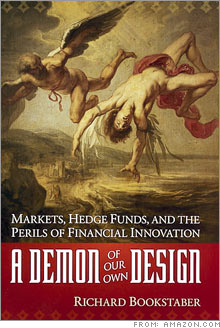Hedging toward another slumpA hedgie comes clean on how he and his ilk helped create the conditions for another crash.(Fortune Magazine) -- There are two reasons I try to avoid reviewing books about investing and markets: first, because they're often written by hucksters or androids (and not particularly talented androids at that), and second, because they have a tendency to illustrate how stupid I am (as if my Schedule D couldn't confirm this). But every so often one pops out of the pile with something original to say, or an original way of saying it. Richard Bookstaber, in "A Demon of Our Own Design: Markets, Hedge Funds, and the Perils of Financial Innovation" (Wiley), accomplishes both of these rare feats.
Bookstaber is a Greenwich, Conn., hedgie, a quant, and one of the early designers of complex risk-management strategies, first at Morgan Stanley (Charts, Fortune 500) and then at Salomon Brothers. He tells us on the very first page that "while it is not strictly true that I caused the two great financial crises of the late 20th century - the 1987 stock market crash and the Long-Term Capital Management (LTCM) hedge fund debacle 11 years later - let's just say I was in the vicinity." This is a very uncharacteristic sentence for a book like this: It tells us Bookstaber is candid, and it tells us he can write. What he proceeds to explain is that the hedging strategies he and others devised - presumably in the interest of stability and caution - have created markets that are unstable and dangerous. The gist of his argument is that instead of minimizing risk, complexity in the markets (and there's no better way to spell complexity than d-e-r-i-v-a-t-i-v-e-s) amplifies it. Stir in the seemingly ever-increasing need for liquidity, and the amplification gets amplified. To wit, this description of a typical day in a typical trading room: "Throughout the day, the ten-year-bond trader gets orders from the derivatives desk to hedge a swap position, from the mortgage desk to hedge mortgage exposure, from insurance clients who need to sell bonds to meet liabilities, and from bond mutual funds that need to invest the proceeds of new accounts. None of these orders has anything to do with information [about value, or even about economic conditions]; each one has everything to do with the need for liquidity." And yet the markets move. Add in some leverage (when spread trades are measured in basis points, you need a heap o' leverage to make them worth the trouble), and you have the perfect environment for catastrophe. When LTCM, suffering a loss, had to liquidate positions to meet margin demands, the sale of liquidated securities, Bookstaber writes, "sucked prices down." Which meant more liquidation. Which meant more insistent demands from creditor banks clamoring for their money. Which meant ... well, you get the idea. The scary thing about all this is that the proliferation of hedging strategies means that potential calamities continue to lurk around the industry. If that's too depressing to contemplate, take heart. Bookstaber makes the occasional arcana of his material appealingly apprehensible through his disquisitions - all of them relevant to his argument - about the origins of primogeniture, the development of Brazilian jujitsu and the behavior of Nile perch. And if you want dish, there are nice helpings of that too. He's occasionally rough on other people he's worked for or with, like Heidi Miller and John Gutfreund, and he's definitely not fond of Sandy Weill ("clearly a man who had made peace with his ego"). But Bookstaber never employs the self-regarding method of dealing with former associates Weill used in his memoir, The Real Deal, a technique that went something like this: "I realize I may have been too tough on Peter Cohen [or Jamie Dimon or John Reed, etc., etc.], and I have to accept the blame for that - even though Cohen [or Dimon or Reed, etc., etc.] was [disloyal or immature, etc., etc.]." Bookstaber, on the contrary, clearly means it when he dons the hair shirt. He helped create this demon, and simply explaining how it came to be is a worthy act of penance. From the July 23, 2007 issue
|
Sponsors
|

